Business Ethics: Theories, Principles, and Informed Consent
VerifiedAdded on 2021/04/21
|8
|1378
|41
Essay
AI Summary
This essay provides a comprehensive overview of business ethics, covering a range of essential topics. It begins by defining professional ethics and its importance, followed by an examination of internal and statutory regulations. The essay then defines ethics and explores the purpose of ethical codes. It delves into ethical dilemmas, including the application of utilitarianism, and provides an example of the 'golden rule' in a business context. The essay further discusses consequential and non-consequential ethical theories, followed by an analysis of Immanuel Kant's ethical principles. Finally, it defines virtue ethics and concludes with a discussion of informed consent, providing relevant examples. The essay offers a clear and concise explanation of key concepts in business ethics, making it a valuable resource for students.
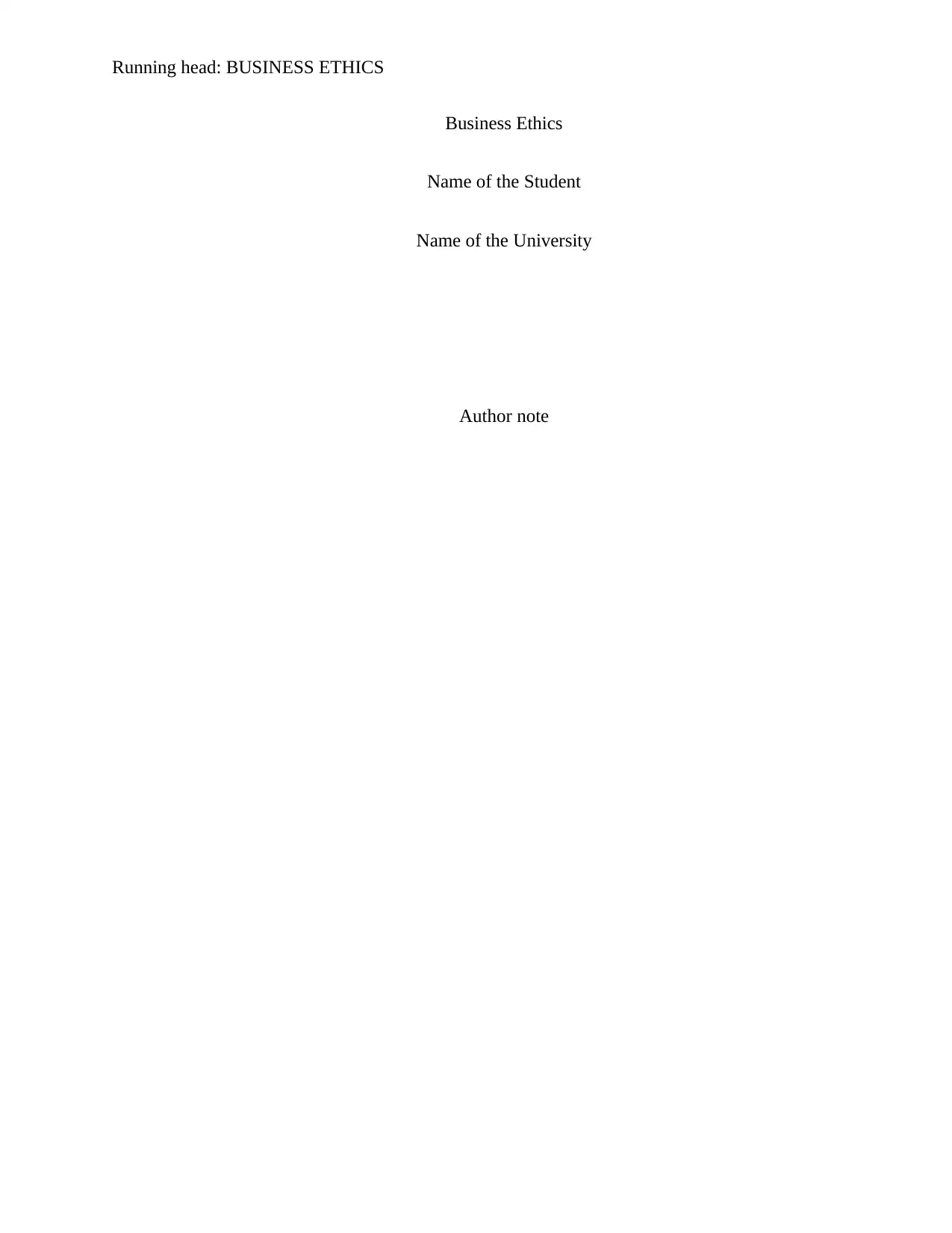
Running head: BUSINESS ETHICS
Business Ethics
Name of the Student
Name of the University
Author note
Business Ethics
Name of the Student
Name of the University
Author note
Paraphrase This Document
Need a fresh take? Get an instant paraphrase of this document with our AI Paraphraser
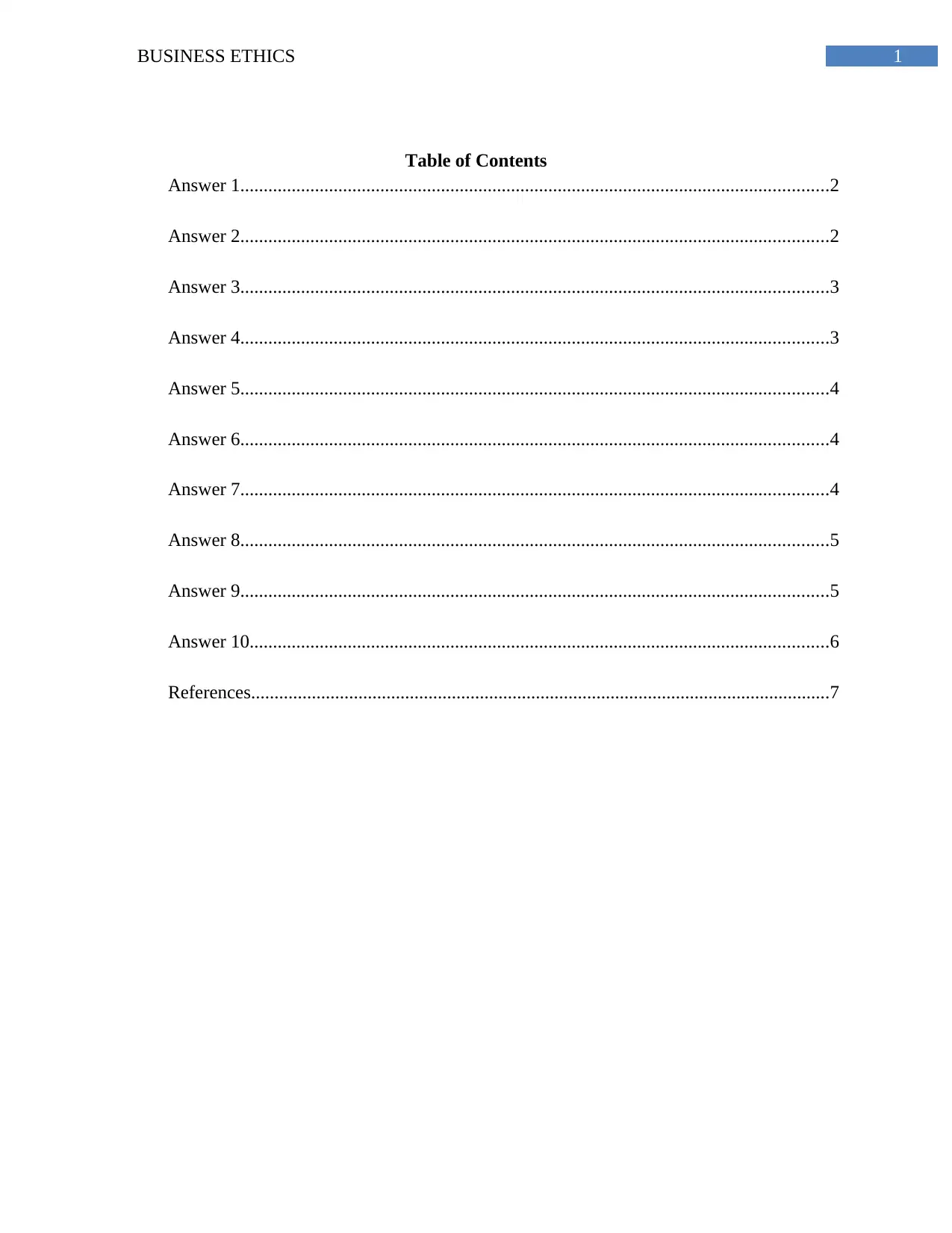
1BUSINESS ETHICS
Table of Contents
Answer 1..............................................................................................................................2
Answer 2..............................................................................................................................2
Answer 3..............................................................................................................................3
Answer 4..............................................................................................................................3
Answer 5..............................................................................................................................4
Answer 6..............................................................................................................................4
Answer 7..............................................................................................................................4
Answer 8..............................................................................................................................5
Answer 9..............................................................................................................................5
Answer 10............................................................................................................................6
References............................................................................................................................7
Table of Contents
Answer 1..............................................................................................................................2
Answer 2..............................................................................................................................2
Answer 3..............................................................................................................................3
Answer 4..............................................................................................................................3
Answer 5..............................................................................................................................4
Answer 6..............................................................................................................................4
Answer 7..............................................................................................................................4
Answer 8..............................................................................................................................5
Answer 9..............................................................................................................................5
Answer 10............................................................................................................................6
References............................................................................................................................7
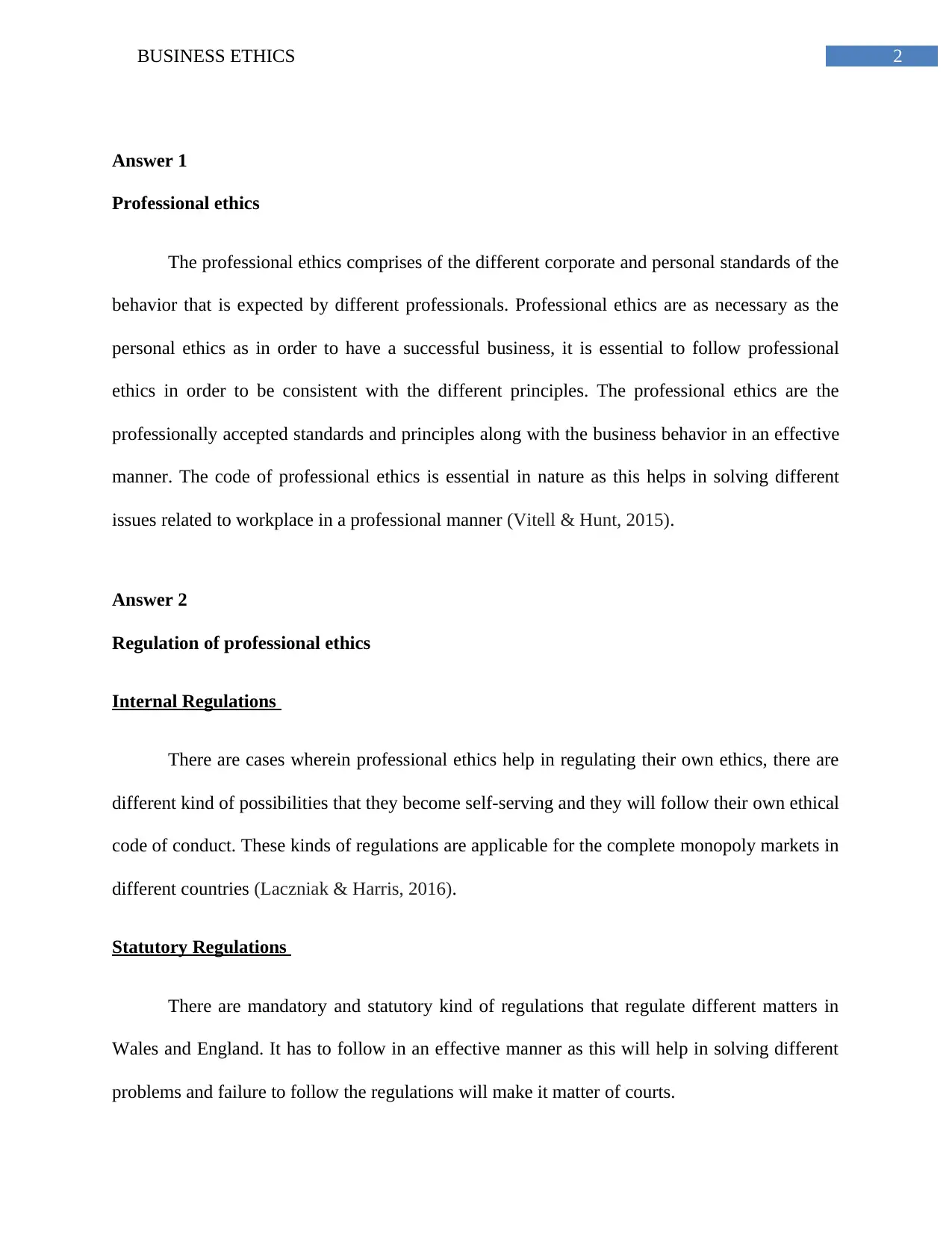
2BUSINESS ETHICS
Answer 1
Professional ethics
The professional ethics comprises of the different corporate and personal standards of the
behavior that is expected by different professionals. Professional ethics are as necessary as the
personal ethics as in order to have a successful business, it is essential to follow professional
ethics in order to be consistent with the different principles. The professional ethics are the
professionally accepted standards and principles along with the business behavior in an effective
manner. The code of professional ethics is essential in nature as this helps in solving different
issues related to workplace in a professional manner (Vitell & Hunt, 2015).
Answer 2
Regulation of professional ethics
Internal Regulations
There are cases wherein professional ethics help in regulating their own ethics, there are
different kind of possibilities that they become self-serving and they will follow their own ethical
code of conduct. These kinds of regulations are applicable for the complete monopoly markets in
different countries (Laczniak & Harris, 2016).
Statutory Regulations
There are mandatory and statutory kind of regulations that regulate different matters in
Wales and England. It has to follow in an effective manner as this will help in solving different
problems and failure to follow the regulations will make it matter of courts.
Answer 1
Professional ethics
The professional ethics comprises of the different corporate and personal standards of the
behavior that is expected by different professionals. Professional ethics are as necessary as the
personal ethics as in order to have a successful business, it is essential to follow professional
ethics in order to be consistent with the different principles. The professional ethics are the
professionally accepted standards and principles along with the business behavior in an effective
manner. The code of professional ethics is essential in nature as this helps in solving different
issues related to workplace in a professional manner (Vitell & Hunt, 2015).
Answer 2
Regulation of professional ethics
Internal Regulations
There are cases wherein professional ethics help in regulating their own ethics, there are
different kind of possibilities that they become self-serving and they will follow their own ethical
code of conduct. These kinds of regulations are applicable for the complete monopoly markets in
different countries (Laczniak & Harris, 2016).
Statutory Regulations
There are mandatory and statutory kind of regulations that regulate different matters in
Wales and England. It has to follow in an effective manner as this will help in solving different
problems and failure to follow the regulations will make it matter of courts.
⊘ This is a preview!⊘
Do you want full access?
Subscribe today to unlock all pages.

Trusted by 1+ million students worldwide
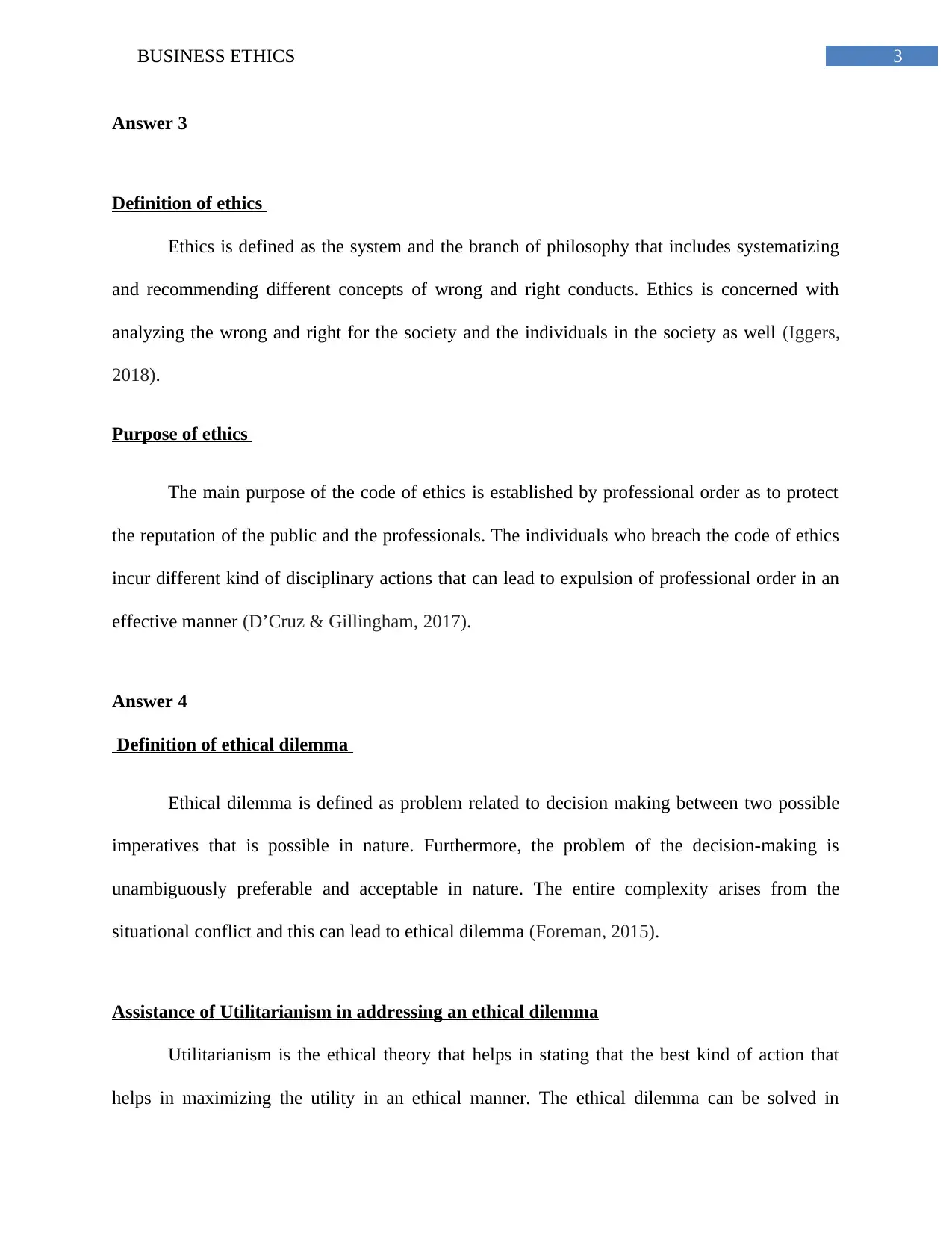
3BUSINESS ETHICS
Answer 3
Definition of ethics
Ethics is defined as the system and the branch of philosophy that includes systematizing
and recommending different concepts of wrong and right conducts. Ethics is concerned with
analyzing the wrong and right for the society and the individuals in the society as well (Iggers,
2018).
Purpose of ethics
The main purpose of the code of ethics is established by professional order as to protect
the reputation of the public and the professionals. The individuals who breach the code of ethics
incur different kind of disciplinary actions that can lead to expulsion of professional order in an
effective manner (D’Cruz & Gillingham, 2017).
Answer 4
Definition of ethical dilemma
Ethical dilemma is defined as problem related to decision making between two possible
imperatives that is possible in nature. Furthermore, the problem of the decision-making is
unambiguously preferable and acceptable in nature. The entire complexity arises from the
situational conflict and this can lead to ethical dilemma (Foreman, 2015).
Assistance of Utilitarianism in addressing an ethical dilemma
Utilitarianism is the ethical theory that helps in stating that the best kind of action that
helps in maximizing the utility in an ethical manner. The ethical dilemma can be solved in
Answer 3
Definition of ethics
Ethics is defined as the system and the branch of philosophy that includes systematizing
and recommending different concepts of wrong and right conducts. Ethics is concerned with
analyzing the wrong and right for the society and the individuals in the society as well (Iggers,
2018).
Purpose of ethics
The main purpose of the code of ethics is established by professional order as to protect
the reputation of the public and the professionals. The individuals who breach the code of ethics
incur different kind of disciplinary actions that can lead to expulsion of professional order in an
effective manner (D’Cruz & Gillingham, 2017).
Answer 4
Definition of ethical dilemma
Ethical dilemma is defined as problem related to decision making between two possible
imperatives that is possible in nature. Furthermore, the problem of the decision-making is
unambiguously preferable and acceptable in nature. The entire complexity arises from the
situational conflict and this can lead to ethical dilemma (Foreman, 2015).
Assistance of Utilitarianism in addressing an ethical dilemma
Utilitarianism is the ethical theory that helps in stating that the best kind of action that
helps in maximizing the utility in an ethical manner. The ethical dilemma can be solved in
Paraphrase This Document
Need a fresh take? Get an instant paraphrase of this document with our AI Paraphraser
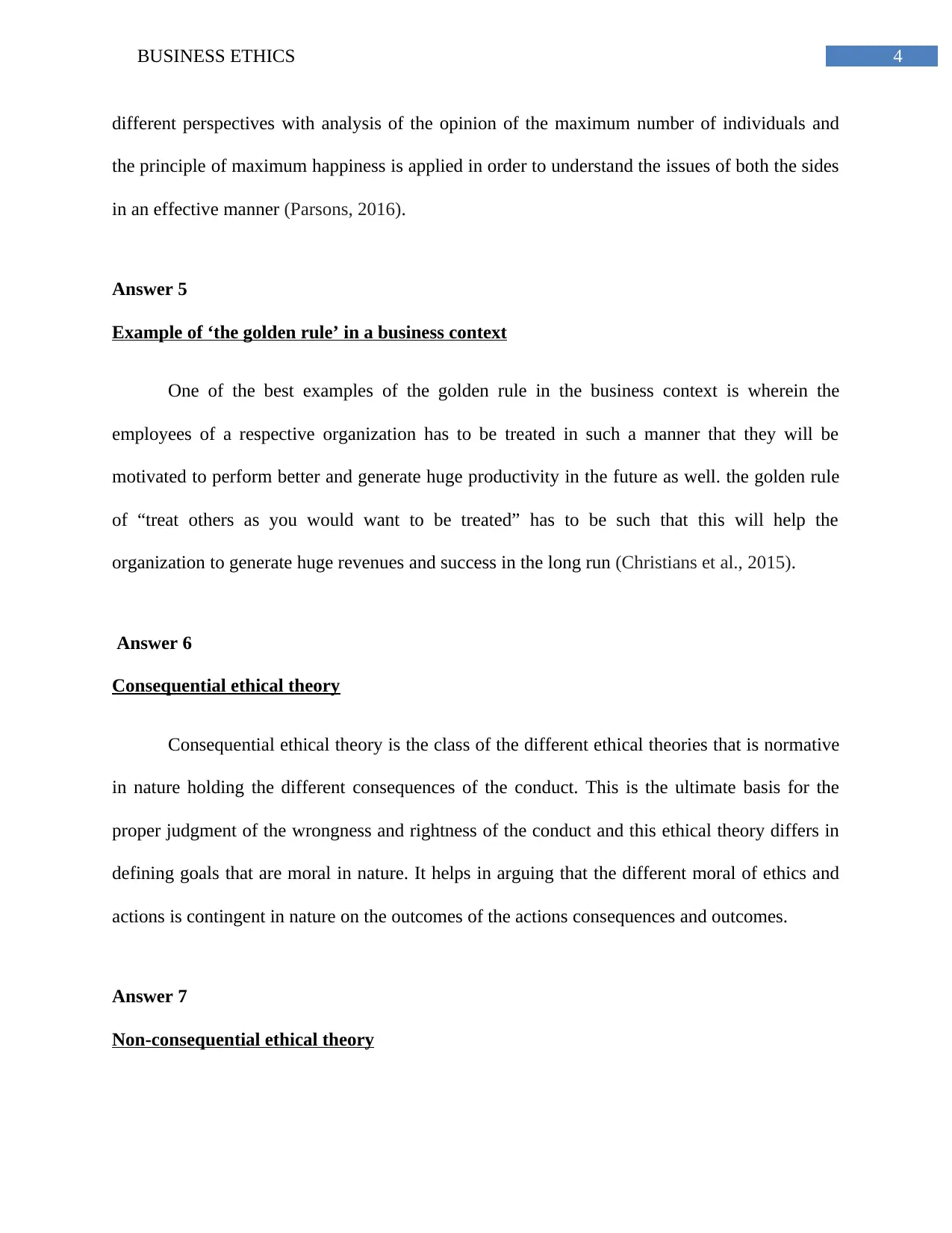
4BUSINESS ETHICS
different perspectives with analysis of the opinion of the maximum number of individuals and
the principle of maximum happiness is applied in order to understand the issues of both the sides
in an effective manner (Parsons, 2016).
Answer 5
Example of ‘the golden rule’ in a business context
One of the best examples of the golden rule in the business context is wherein the
employees of a respective organization has to be treated in such a manner that they will be
motivated to perform better and generate huge productivity in the future as well. the golden rule
of “treat others as you would want to be treated” has to be such that this will help the
organization to generate huge revenues and success in the long run (Christians et al., 2015).
Answer 6
Consequential ethical theory
Consequential ethical theory is the class of the different ethical theories that is normative
in nature holding the different consequences of the conduct. This is the ultimate basis for the
proper judgment of the wrongness and rightness of the conduct and this ethical theory differs in
defining goals that are moral in nature. It helps in arguing that the different moral of ethics and
actions is contingent in nature on the outcomes of the actions consequences and outcomes.
Answer 7
Non-consequential ethical theory
different perspectives with analysis of the opinion of the maximum number of individuals and
the principle of maximum happiness is applied in order to understand the issues of both the sides
in an effective manner (Parsons, 2016).
Answer 5
Example of ‘the golden rule’ in a business context
One of the best examples of the golden rule in the business context is wherein the
employees of a respective organization has to be treated in such a manner that they will be
motivated to perform better and generate huge productivity in the future as well. the golden rule
of “treat others as you would want to be treated” has to be such that this will help the
organization to generate huge revenues and success in the long run (Christians et al., 2015).
Answer 6
Consequential ethical theory
Consequential ethical theory is the class of the different ethical theories that is normative
in nature holding the different consequences of the conduct. This is the ultimate basis for the
proper judgment of the wrongness and rightness of the conduct and this ethical theory differs in
defining goals that are moral in nature. It helps in arguing that the different moral of ethics and
actions is contingent in nature on the outcomes of the actions consequences and outcomes.
Answer 7
Non-consequential ethical theory
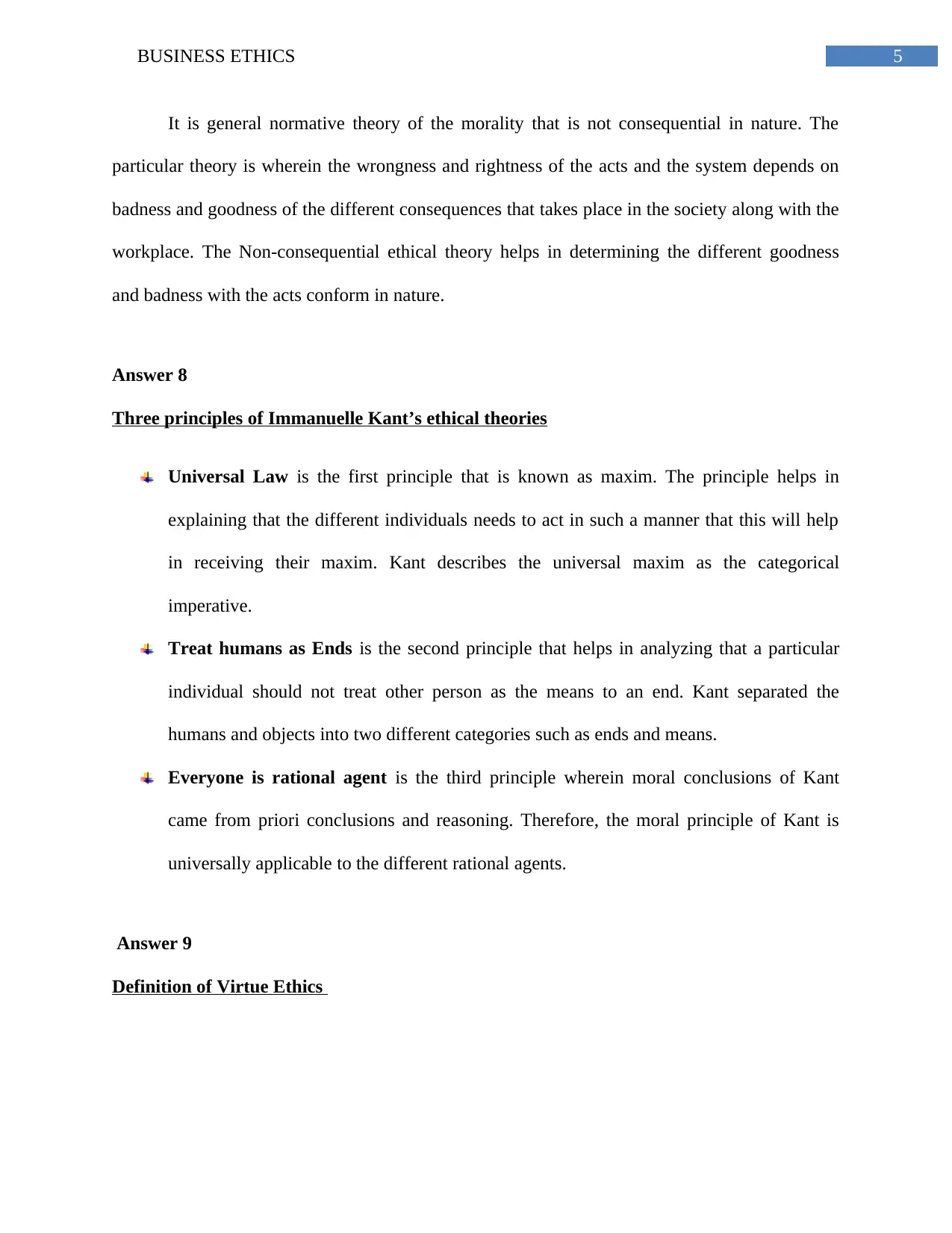
5BUSINESS ETHICS
It is general normative theory of the morality that is not consequential in nature. The
particular theory is wherein the wrongness and rightness of the acts and the system depends on
badness and goodness of the different consequences that takes place in the society along with the
workplace. The Non-consequential ethical theory helps in determining the different goodness
and badness with the acts conform in nature.
Answer 8
Three principles of Immanuelle Kant’s ethical theories
Universal Law is the first principle that is known as maxim. The principle helps in
explaining that the different individuals needs to act in such a manner that this will help
in receiving their maxim. Kant describes the universal maxim as the categorical
imperative.
Treat humans as Ends is the second principle that helps in analyzing that a particular
individual should not treat other person as the means to an end. Kant separated the
humans and objects into two different categories such as ends and means.
Everyone is rational agent is the third principle wherein moral conclusions of Kant
came from priori conclusions and reasoning. Therefore, the moral principle of Kant is
universally applicable to the different rational agents.
Answer 9
Definition of Virtue Ethics
It is general normative theory of the morality that is not consequential in nature. The
particular theory is wherein the wrongness and rightness of the acts and the system depends on
badness and goodness of the different consequences that takes place in the society along with the
workplace. The Non-consequential ethical theory helps in determining the different goodness
and badness with the acts conform in nature.
Answer 8
Three principles of Immanuelle Kant’s ethical theories
Universal Law is the first principle that is known as maxim. The principle helps in
explaining that the different individuals needs to act in such a manner that this will help
in receiving their maxim. Kant describes the universal maxim as the categorical
imperative.
Treat humans as Ends is the second principle that helps in analyzing that a particular
individual should not treat other person as the means to an end. Kant separated the
humans and objects into two different categories such as ends and means.
Everyone is rational agent is the third principle wherein moral conclusions of Kant
came from priori conclusions and reasoning. Therefore, the moral principle of Kant is
universally applicable to the different rational agents.
Answer 9
Definition of Virtue Ethics
⊘ This is a preview!⊘
Do you want full access?
Subscribe today to unlock all pages.

Trusted by 1+ million students worldwide
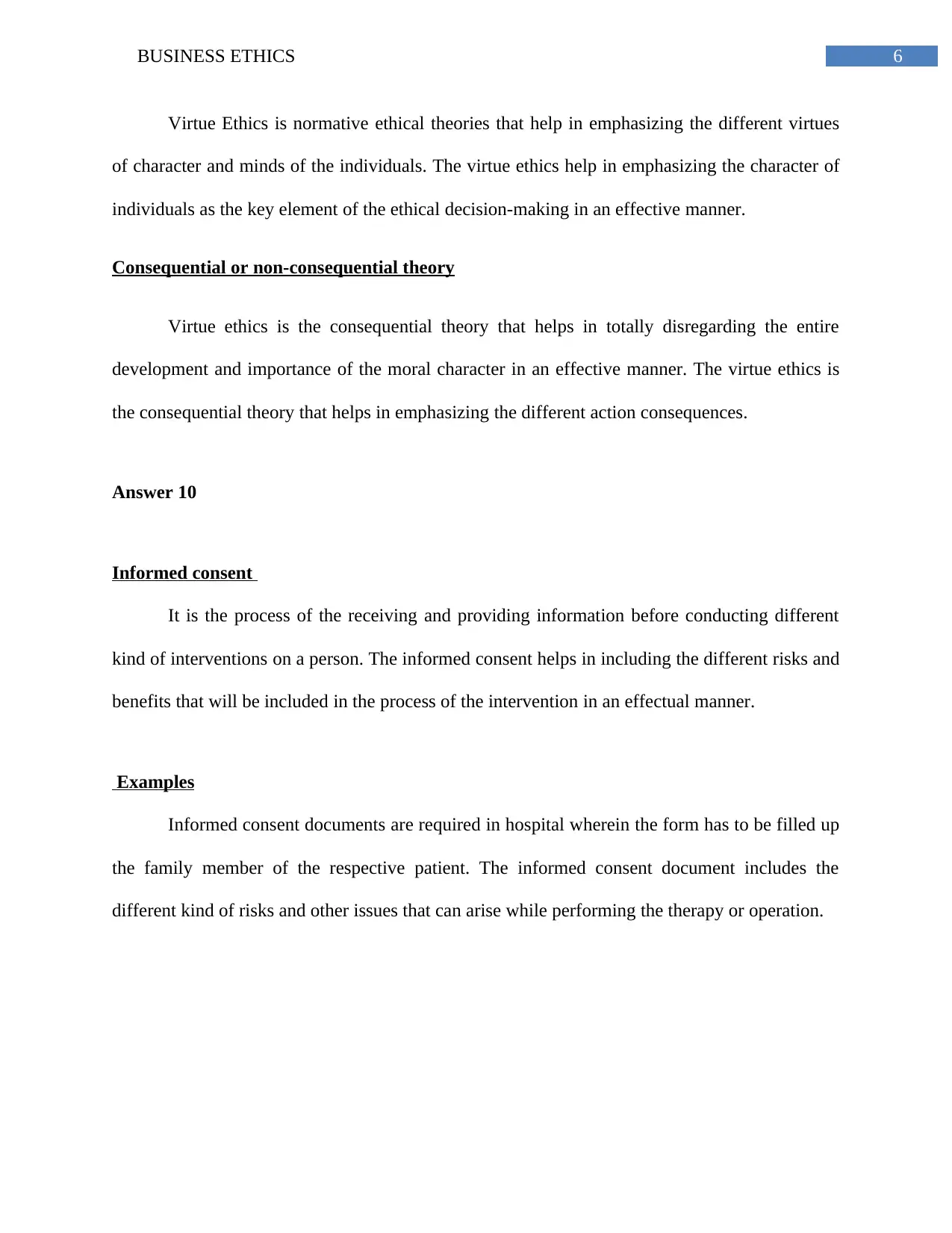
6BUSINESS ETHICS
Virtue Ethics is normative ethical theories that help in emphasizing the different virtues
of character and minds of the individuals. The virtue ethics help in emphasizing the character of
individuals as the key element of the ethical decision-making in an effective manner.
Consequential or non-consequential theory
Virtue ethics is the consequential theory that helps in totally disregarding the entire
development and importance of the moral character in an effective manner. The virtue ethics is
the consequential theory that helps in emphasizing the different action consequences.
Answer 10
Informed consent
It is the process of the receiving and providing information before conducting different
kind of interventions on a person. The informed consent helps in including the different risks and
benefits that will be included in the process of the intervention in an effectual manner.
Examples
Informed consent documents are required in hospital wherein the form has to be filled up
the family member of the respective patient. The informed consent document includes the
different kind of risks and other issues that can arise while performing the therapy or operation.
Virtue Ethics is normative ethical theories that help in emphasizing the different virtues
of character and minds of the individuals. The virtue ethics help in emphasizing the character of
individuals as the key element of the ethical decision-making in an effective manner.
Consequential or non-consequential theory
Virtue ethics is the consequential theory that helps in totally disregarding the entire
development and importance of the moral character in an effective manner. The virtue ethics is
the consequential theory that helps in emphasizing the different action consequences.
Answer 10
Informed consent
It is the process of the receiving and providing information before conducting different
kind of interventions on a person. The informed consent helps in including the different risks and
benefits that will be included in the process of the intervention in an effectual manner.
Examples
Informed consent documents are required in hospital wherein the form has to be filled up
the family member of the respective patient. The informed consent document includes the
different kind of risks and other issues that can arise while performing the therapy or operation.
Paraphrase This Document
Need a fresh take? Get an instant paraphrase of this document with our AI Paraphraser
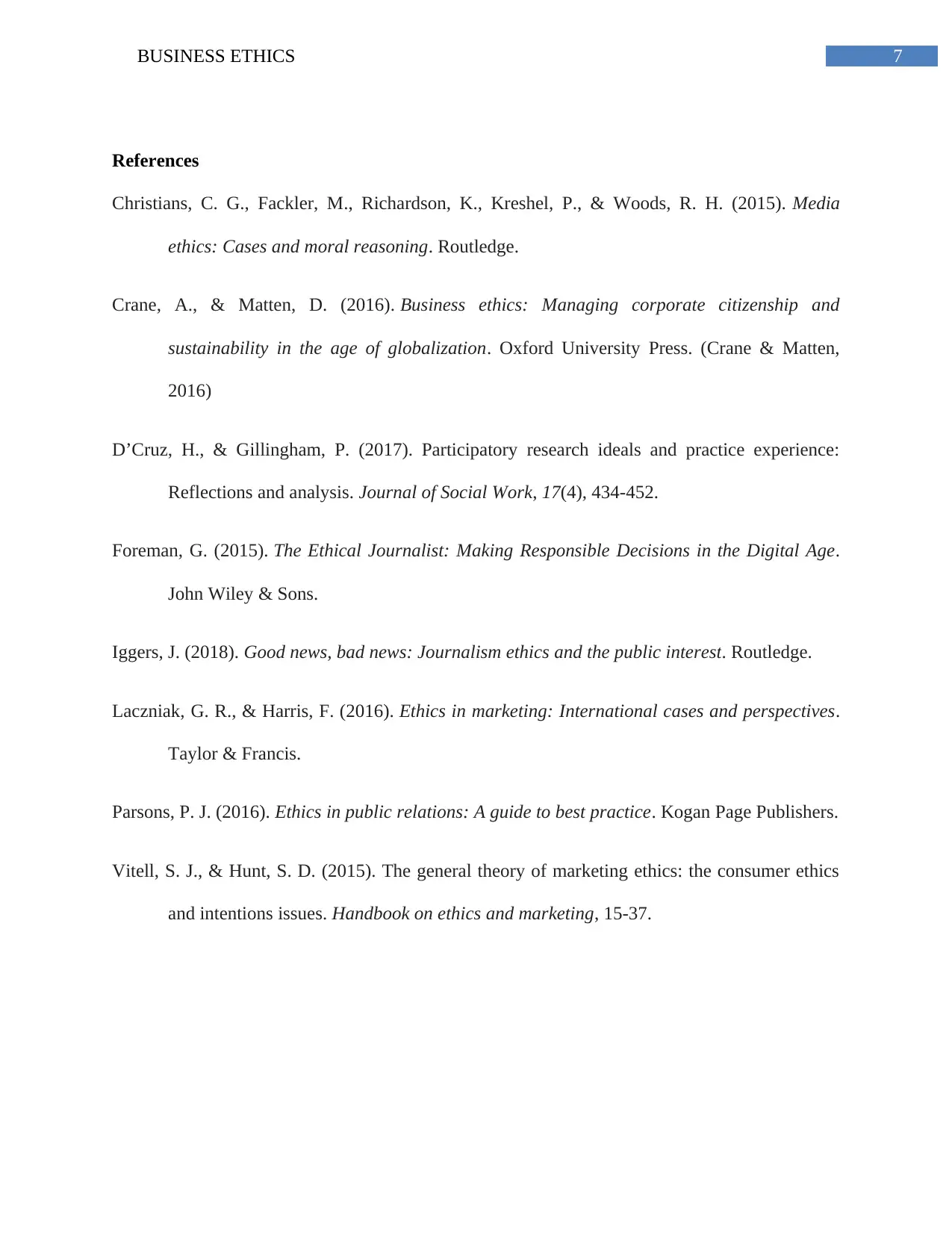
7BUSINESS ETHICS
References
Christians, C. G., Fackler, M., Richardson, K., Kreshel, P., & Woods, R. H. (2015). Media
ethics: Cases and moral reasoning. Routledge.
Crane, A., & Matten, D. (2016). Business ethics: Managing corporate citizenship and
sustainability in the age of globalization. Oxford University Press. (Crane & Matten,
2016)
D’Cruz, H., & Gillingham, P. (2017). Participatory research ideals and practice experience:
Reflections and analysis. Journal of Social Work, 17(4), 434-452.
Foreman, G. (2015). The Ethical Journalist: Making Responsible Decisions in the Digital Age.
John Wiley & Sons.
Iggers, J. (2018). Good news, bad news: Journalism ethics and the public interest. Routledge.
Laczniak, G. R., & Harris, F. (2016). Ethics in marketing: International cases and perspectives.
Taylor & Francis.
Parsons, P. J. (2016). Ethics in public relations: A guide to best practice. Kogan Page Publishers.
Vitell, S. J., & Hunt, S. D. (2015). The general theory of marketing ethics: the consumer ethics
and intentions issues. Handbook on ethics and marketing, 15-37.
References
Christians, C. G., Fackler, M., Richardson, K., Kreshel, P., & Woods, R. H. (2015). Media
ethics: Cases and moral reasoning. Routledge.
Crane, A., & Matten, D. (2016). Business ethics: Managing corporate citizenship and
sustainability in the age of globalization. Oxford University Press. (Crane & Matten,
2016)
D’Cruz, H., & Gillingham, P. (2017). Participatory research ideals and practice experience:
Reflections and analysis. Journal of Social Work, 17(4), 434-452.
Foreman, G. (2015). The Ethical Journalist: Making Responsible Decisions in the Digital Age.
John Wiley & Sons.
Iggers, J. (2018). Good news, bad news: Journalism ethics and the public interest. Routledge.
Laczniak, G. R., & Harris, F. (2016). Ethics in marketing: International cases and perspectives.
Taylor & Francis.
Parsons, P. J. (2016). Ethics in public relations: A guide to best practice. Kogan Page Publishers.
Vitell, S. J., & Hunt, S. D. (2015). The general theory of marketing ethics: the consumer ethics
and intentions issues. Handbook on ethics and marketing, 15-37.
1 out of 8
Related Documents
Your All-in-One AI-Powered Toolkit for Academic Success.
+13062052269
info@desklib.com
Available 24*7 on WhatsApp / Email
![[object Object]](/_next/static/media/star-bottom.7253800d.svg)
Unlock your academic potential
Copyright © 2020–2025 A2Z Services. All Rights Reserved. Developed and managed by ZUCOL.




